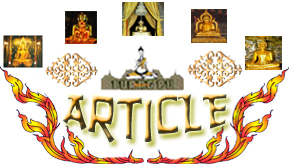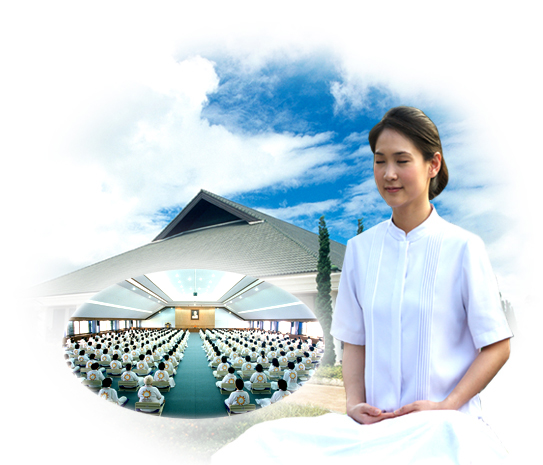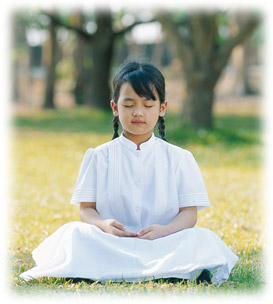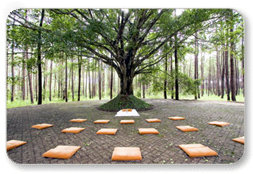6018 Read A Guide to meditation in Thailand (Part 2)
Sawasdeeka^_^,
Last article, we let anyone know about meditaion in Thailand(Part 1) from http://www.dhammathai.org/. This article, we'll follow up meditation in Thailand (Part 2).



 LIVING AT A WAT OR MEDITATION CENTRE LIVING AT A WAT OR MEDITATION CENTRE
Greeting People
Thai wat etiquette, which stems largely from the monk's code of discipline, forms the national ideal of polite behavior in many ways.
By following Thai customs, foreigners can show appreciation to the Thai people and ensure a welcome reception for future visitors. Gestures of respect also help to develop kindness and sensitivity to others. The anjali (wai or pranom) of raising hands to the chest with palms together is used for (1) Greeting other people; (2) When speaking with a monk; (3) After offering something to an ordained person; and (4) Before receiving something from an ordained person. (Laypeople return the anjali but ordained people are not supposed to return one from a layperson.) Thais address senior monks as Ajahn, other monks as Tahn, novices as Nayn. The title can be used by itself or preceding the Pali name; it's impolite to use the Pali name without a title.

Body Language
Thais place great importance on body posture when around monks, especially if the monks are teaching Dhamma. Laypeople stoop slightly when walking past a seated monk. If walking with a monk, they try to walk a little behind. Laypeople never talk or listen to monks from a higher position; they sit or at least squat down before addressing a seated monk. When listening to a sermon or talking with a monk, women usually sit in a "mermaid" posture; men more often sit with one leg crossed in front and the other tucked behind; the kneeling position is polite for both sexes. Cross-legged positions are less polite and they're normally just used in meditation. Avoid sitting with arms clasped around the raised knees (impolite). In a chair, sit erect and attentive. Laypeople never sit on the asana (raised seat for monks and novices), same seat or mat as a monk, or on a monk's robes.
Bowing
Thais have many variations on the kraap (bowing), but it's always done 3 times in respect for the "Triple Gem" of Buddha, Dhamma, and Sangha. Follow the example of Thai laypeople around you as to when to bow; usually one bows before being seated in a hall with a Buddha image or when meeting with a monk and again before getting up and leaving. Bowing can be done as a meditation and reflection on each part of the Triple Gem. Bow slowly and mindfully, bringing the forehead all the way to the floor, keep buttocks on the heels, elbows near the knees, and thumbs near the eyebrows.
Offering
Giving of the monks' requisites develops respect and generosity. Thais traditionally bring flowers, candles, and incense when they visit a wat, though any small gift is appreciated by the monastic community. Come up with head bowed in a kneeling or squatting position to within arms' reach of the monk, then use both hands to place an offering into the monk's hands. Women must place items on a cloth laid in front by the monk or have a layman pass them; similarly, men should respect women with shaved heads who may not want to receive or hand anything directly. Both men and women place food directly into the monk's bowl during pindabat. After presenting an offering, make the anjali. Offerings of money should be placed in a donation book or given to a designated layperson.
Other Important Customs
(1) Women need to understand the monks' discipline of not touching or being alone in a closed room with a woman. Women should try to avoid entering a library or other room where this could happen.
(2) Men and women sometimes sit in separate areas during group meetings; you can observe and follow the Thais of the same gender.
(3) Thais use feet for walking and standing, then tuck them away at other times; be especially careful never to point out or stretch out one's feet in the direction of a Buddha image or monk.
(4) Shoes are generally taken off before entering a room with a Buddha image or in any residence.
(5) Sleeping pillows should only be used to rest the head -- considered sacred by the Thais and never for sitting on.
(6) Food and drink are consumed in a seated or squatting position.
(7) A bathing cloth must be worn when using outdoor bathing areas, common in rural areas (Thais are extremely modest).

 THAILAND PRACTICALITIES THAILAND PRACTICALITIES
Food
Thai food may take a bit of getting used to, as some dishes are highly spiced. Generally you'll find the cuisine tasty and varied with plenty of both spicy and nonspicy dishes to choose from. Meals have white rice (sticky rice in the northeast) with meat, fish, vegetables, fruit, and sweets. Food offered in remote forest monasteries tends to be simpler and less varied, though is usually quite good. A few wats and centres (mentioned in the individual descriptions) offer vegetarian food. Like the monks and nuns, lay visitors normally eat only between sunrise and mid-day. This rule of the Buddha's makes the monastic community easy to support and contributes to moderation in eating. (If needed for medical reasons, food can also be taken after mid-day at most places.)
Clothing
Thais always wear modest clothing that's clean and neat to a wat or meditation centre. They avoid tight-fitting or bright-colored clothing that might be distracting to others. Shirts and blouses have sleeves. Men wear long pants; women use skirts that come below the knees. Some wats and centres ask that men wear white clothing and that women wear either all white or a white blouse and black skirt. Clothing can occasionally be borrowed or you can outfit yourself in a local shop at low cost. Even when not required, the wearing of white serves as a reminder that one is undertaking a spiritual life.
Climate
Thailand has 3 seasons, the cool from Nov. through Feb., hot from March through June, and the rainy from July through October. (The rainy season in the south lasts through January.) Pronounced variations can occur from region to region and year to year. The northeast has the most distinct seasons; lows can get down to 0-15 degrees C (32-59 degrees F) in the cool months; hot-season highs can exceed 40 degrees C (104 degrees F). The north has a similar climate, but doesn't get as hot. Central Thailand stays warm to hot year-round. The south has a tropical climate; the region rarely sees extremes of heat or cold. South and central Thailand have high humidity, which decreases as one moves inland to the northern and northeastern regions. Any season can be fine for a visit to Thailand -- just be prepared with warm clothes for the cool season in the north and northeast, umbrella or poncho for the rainy season, and light weight cotton clothing for the hot season. People from cool climates will have an easier time adjusting to the climate if they arrive in the cool or rainy seasons.
Health
You're likely to stay healthy in Thailand, thanks to high standards of hygiene and medical care. Malaria does exist in some outlying areas; current advice urges people to use netting and repellent from dusk to dawn, when disease-carrying mosquitos bite, rather than rely on preventative pills. The pills can have bad side effects; also, they don't protect against all malaria strains. If you get an unexplained fever, especially a recurrent one, obtain a blood test right away; a doctor can then determine the most effective treatment.
Getting There
You can reach Thailand easily by air from most major cities in the world and by land from Malaysia and possibly from Laos. Sorting through all the fares and restrictions of airlines can be difficult, so let a good travel agent do the work for you. The best deals can often be found in cities with large Asian populations; check ads in the Sunday travel section of newspapers of these cities. Discounted fares from agents specializing in Asia can be hundreds of dollars less than the cheapest fare the airline will quote directly. Carefully check restrictions -- cheap (and some not so cheap) tickets won't be refundable and generally don't allow route changes. Some roundtrip tickets allow
only short visits of 45 days to 6 months; shop around for a one-year fare or just buy a one-way ticket if you might want to stay longer. Bangkok travel agencies have great deals on international flights, though be sure to stick to well-established agencies.
Getting Around
Thailand has a well-developed public transport system of train, bus, and air routes. Getting around is easier, more efficient, and less expensive than in most western and Asian countries. Taxis offer good value too, though one often has to bargain. A little Thai helps a lot with local transport. The Lonely Planet book Thailand; a travel survival kit by Joe Cummings has good information on getting to and around the country, as well as details on the sights and culture.
Visas
Check visa requirements before you come. Most people obtain a Tourist Visa (good for 2 months and extendable one month more). Longer-term visitors can try for a Non-Immigrant visa (good for at least 3 months and possibly extendable); a stay of more than 3 months can get complicated with various sponsorship letters required; ask advice in Thailand. Often it's easiest to zip down to the Thai Consulate in Penang, Malaysia, for a new visa, then return for another 3 months; this consulate issues Non-Immigrant visas more easily than most if you have a good reason (such as meditation practice).
Language
Ability to speak Thai will allow you to communicate directly with all of the teachers in Thailand, most of whom speak little or no English. You'll also benefit from the many Dhamma talks in Thai available on cassette recordings. The language has very simple grammar, so most of the effort in speaking Thai goes into learning vocabulary and the all important 5 tones. The written alphabet can be learned along with the vocabulary or studied later. One or 2 months of intensive language study will enable you to understand basic meditation instructions and much of the material presented in Dhamma talks. Bangkok has some good language schools.
 THE FOUR NOBLE TRUTHS THE FOUR NOBLE TRUTHS
We can experience these truths, which lie at the heart of the Buddha's teachings, through direct experience. They can be viewed as
(1) Diagnosis of an illness;
(2) Prognosis;
(3) Recovery; and
(4) Medicine to cure the disease.
The first 2 truths deal with the way things are; the last 2 point the way to freedom from suffering.
1. The Noble Truth of Suffering
Besides "suffering," other translations of the Pali word dukkha include unsatisfactoriness, dis-ease, and instability. All these words point to the fact that no conditioned phenomenon can provide true (lasting) happiness in our lives. The first step in a spiritual life is to look very closely and honestly at our experience of life and see that there is suffering. We tend to overlook or ignore or just blindly react to the unpleasant, so it continually haunts us. Yet although physical suffering is a natural aspect of our lives, we can learn to transcend mental suffering.
2. The Noble Truth of the Cause of Suffering
Through a lack of understanding of how things truely exist, we create and recreate an independent self entity called "me."
The whole of our experience in life can be viewed through this sense of self. In consequence, various cravings govern our actions. Cravings arise for sense experiences, for "being" or "becoming" (e.g. rich, famous, loved, respected, immortal), and to avoid the unpleasant. These cravings are the root cause of suffering.
3. The Noble Truth of the Cessation of Suffering
The mind can be purified of all the mental defilements that cause suffering. Nibbana, the ultimate peace, has been compared to the extinction of a three-fold fire of lust, ill-will, and delusion. One who has realised cessation has great purity of heart, ocean-like compassion, and penetrating wisdom.
4. The Noble Truth of the Way to the Cessation of Suffering
The Way leading to cessation contains a thorough and profound training of body, speech, and mind. Traditionally it's outlined as the Noble Eightfold Path: (1) Right Understanding; (2) Right Intention; (3) Right Speech; (4) Right Action; (5) Right Livelihood; (6) Right Effort; (7) Right Mindfulness; and (8) Right Concentration. On the level of morality (sila), the Path entails restraint and care in speech, action, and livelihood. The concentration (samadhi) level requires constant effort to abandon the unwholesome and develop the wholesome, to increase mindfulness and clear comprehension of the mind-body process, and to develop mental calm and stability. The wisdom (panna) level entails the abandonment of thoughts of sensuality, ill-will, and cruelty; ultimately it penetrates the true nature of phenomena to see impermanence, unsatisfactoriness, and impersonality. When all 8 factors of the Path come together in harmony to the point of maturity, suffering is transcended. In summary, the Four Noble Truths can be thought of as that which is to be
(1) comprehended, (2) abandoned, (3) realized, and (4) developed.
 TAKING THE PRECEPTS TAKING THE PRECEPTS
The Buddha's path to liberation begins from a foundation of moral discipline (sila). Taking care of our actions through restraint allows the mind to readily develop concentration and wisdom. A basic moral discipline also brings happiness, self-confidence, and self- respect.
Five precepts -- guidelines to good conduct -- can be undertaken by everyone: (1) Refraining from taking life; (2) Refraining from taking what is not given; (3) Refraining from sexual misconduct; (4) Refraining from false or harmful speech; and (5) Refraining from intoxicants. As with other teachings of the Buddha, the precepts invite reflection, wisdom, and compassion in their application. The precepts provide a standard of behavior that has great power. Standing by the precepts prevents the harmful actions and speech that might otherwise occur when strong feelings of hate, greed, or sexual desire beset the mind.
Laypeople visiting a wat on wan phra (full-, new-, and half-moon days) or anytime for meditation may choose to observe 8 precepts; these include the 5 precepts (#3 changes to refraining from any sexual activity) with (6) Refraining from eating solid food after mid-day;
(7) Refraining from dancing, singing, music and shows, garlands, perfumes, cosmetics, and adornments; and (8) Refraining from luxurious and high seats and beds. The 8 precepts may at first appear difficult, but in a monastic environment they help direct one's mind toward spiritual development.
 HELPFUL HINTS ON USING THE LISTINGS HELPFUL HINTS ON USING THE LISTINGS
Names and addresses have been written in Thai script as well as English for this edition. [NOTE: the Thai script is not available in the online edition] The Thai will help convey your destination to bus, songtaew, and taxi drivers. Many characters of the Thai alphabet have no precise English equivalent; if you can read or have someone pronounce the names in Thai, you'll know how to say them correctly.
Thailand has 76 provinces (jangwat), which are divided into districts (amper or amphoe), and subdivided into precincts (tambon or tambol). The word ban means "village." If you see amper muang in an address, that means it's in the capital district of that province (provinces take the same name as their capital).
Many wats and meditation centres in Thailand have telephones, but you're not likely to get someone who speaks English; try to have a Thai friend call for you if you don't speak Thai. Telephone area codes, in parentheses, are used only if calling from another area code.
Some wats and centres, as noted in the "Write in Advance?" section, prefer that you write ahead with your plans to visit; but even if not required, an advance letter will always be appreciated.

source : http://www.dhammathai.org/
|

